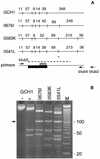Sequence polymorphism in the beta-tubulin gene reveals heterogeneous and variable population structures in Cryptosporidium parvum
- PMID: 9797309
- PMCID: PMC106671
- DOI: 10.1128/AEM.64.11.4477-4481.1998
Sequence polymorphism in the beta-tubulin gene reveals heterogeneous and variable population structures in Cryptosporidium parvum
Abstract
Restriction fragment length polymorphism (RFLP) analysis of isolates of Cryptosporidium parvum has revealed two subgroups, termed H and C. The limited resolution of the RFLP method precludes an in-depth study of the genetic structure of C. parvum populations. Published C. parvum restriction polymorphisms lie within protein-coding regions known to be more homogeneous than noncoding sequences. To better assess the degrees of heterogeneity between and within C. parvum isolates, sequence polymorphism in the beta-tubulin intron, the only C. parvum intron described to date, was investigated. In contrast to the two genotypes distinguished by multilocus RFLP, several alleles were detected by sequence and RFLP analysis of the beta-tubulin intron and adjacent exon 2. Isolates carrying different beta-tubulin alleles were found. Significantly, one of the beta-tubulin alleles present in two geographically unrelated isolates combined features of C- and H-type isolates, suggesting that it might have arisen from a recombination event. A comparison of multiple samples of a calf-propagated laboratory isolate showed that the ratio of different beta-tubulin alleles fluctuated during serial passage.
Figures



Similar articles
-
A study of Cryptosporidium parvum genotypes and population structure.Mem Inst Oswaldo Cruz. 1998 Sep-Oct;93(5):685-6. doi: 10.1590/s0074-02761998000500021. Mem Inst Oswaldo Cruz. 1998. PMID: 9830538
-
Genetic polymorphism at the beta-tubulin locus among human and animal isolates of Cryptosporidium parvum.FEMS Microbiol Lett. 1999 Jan 1;170(1):173-9. doi: 10.1111/j.1574-6968.1999.tb13371.x. FEMS Microbiol Lett. 1999. PMID: 9919666
-
Biallelic polymorphism in the intron region of beta-tubulin gene of Cryptosporidium parasites.J Parasitol. 1999 Feb;85(1):154-7. J Parasitol. 1999. PMID: 10207387
-
[Comparative study of PCR-based Cryptosporidium discriminating techniques with a review of the literature].Kansenshogaku Zasshi. 2002 Oct;76(10):869-81. doi: 10.11150/kansenshogakuzasshi1970.76.869. Kansenshogaku Zasshi. 2002. PMID: 12448847 Review. Japanese.
-
Genetic polymorphism among Cryptosporidium parvum isolates: evidence of two distinct human transmission cycles.Emerg Infect Dis. 1997 Oct-Dec;3(4):567-73. doi: 10.3201/eid0304.970423. Emerg Infect Dis. 1997. PMID: 9366611 Free PMC article. Review.
Cited by
-
PCR-restriction fragment length polymorphism analysis of a diagnostic 452-base-pair DNA fragment discriminates between Cryptosporidium parvum and C. meleagridis and between C. parvum isolates of human and animal origin.Appl Environ Microbiol. 2002 Apr;68(4):2071-6. doi: 10.1128/AEM.68.4.2071-2076.2002. Appl Environ Microbiol. 2002. PMID: 11916736 Free PMC article.
-
Detection and differentiation of Cryptosporidium parasites that are pathogenic for humans by real-time PCR.J Clin Microbiol. 2002 Jul;40(7):2335-8. doi: 10.1128/JCM.40.7.2335-2338.2002. J Clin Microbiol. 2002. PMID: 12089244 Free PMC article.
-
Detection and genotyping of oocysts of Cryptosporidium parvum by real-time PCR and melting curve analysis.J Clin Microbiol. 2002 Sep;40(9):3237-44. doi: 10.1128/JCM.40.9.3237-3244.2002. J Clin Microbiol. 2002. PMID: 12202559 Free PMC article.
-
Genetic characterization and transmission cycles of Cryptosporidium species isolated from humans in New Zealand.Appl Environ Microbiol. 2004 Jul;70(7):3973-8. doi: 10.1128/AEM.70.7.3973-3978.2004. Appl Environ Microbiol. 2004. PMID: 15240272 Free PMC article.
-
Gene analysis of Cryptosporidium parvum HNJ-1 strain isolated in Japan.Parasitol Res. 2005 Dec;97(6):452-7. doi: 10.1007/s00436-005-1474-8. Epub 2005 Sep 9. Parasitol Res. 2005. PMID: 16151736
References
-
- Awad-El-Kariem F M, Robinson H A, Dyson D A, Evans D, Wright S, Fox T M, McDonald V. Differentiation between human and animal strains of Cryptosporidium parvum using isoenzyme typing. Parasitology. 1995;110:129–132. - PubMed
-
- Awad-El-Kariem F M, Robinson H A, Petry F, McDonald V, Evans D, Casemore D. Differentiation between human and animal isolates of Cryptosporidium parvum using molecular and biological markers. Parasitol Res. 1998;84:297–301. - PubMed
-
- Bonnin A, Fourmaux M N, Dubremetz J F, Nelson R G, Gobet P, Harly G, Buisson M, Puygauthier-Toubas D, Gabriel-Pospisil F, Naciri M, Camerlynck P. Genotyping human and bovine isolates of Cryptosporidium parvum by polymerase chain reaction-restriction fragment length polymorphism analysis of a repetitive DNA sequence. FEMS Microbiol Lett. 1996;137:207–211. - PubMed
-
- Cacciò S, La Rosa G, Pozio E. The beta-tubulin gene of Cryptosporidium parvum. Mol Biochem Parasitol. 1997;89:307–311. - PubMed
Publication types
MeSH terms
Substances
Grants and funding
LinkOut - more resources
Full Text Sources

